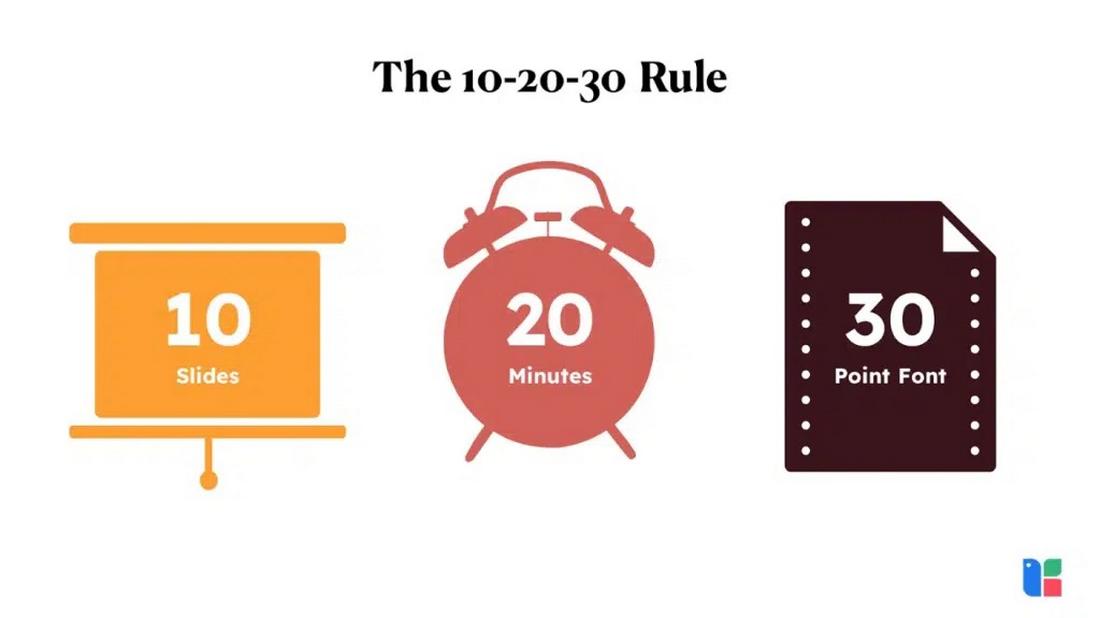The 10-20-30 Rule: Does It Still Apply to Modern Presentations?
In the mid-2000s, Guy Kawasaki, a renowned venture capitalist and former Apple evangelist, introduced the 10-20-30 rule for crafting effective presentations.
This guideline suggests that a presentation should consist of no more than ten slides, last no longer than twenty minutes, and use a font size of at least thirty points. The rule was designed to promote clarity, brevity, and audience engagement.
However, with the evolution of presentation tools and changing audience expectations, it’s worth examining whether the 10-20-30 rule remains relevant today. And that’s exactly what we aim to do in this post. Let’s dive in.
What is the 10-20-30 Rule?

(Source: Kapable)
The 10-20-30 rule was popularized by Guy Kawasaki, a well-known speaker and author. He believed that limiting the number of slides and keeping the presentation short helps the speaker focus on the main message.
The rule is simple. It advises using no more than 10 slides so that you do not overwhelm your audience. This has also been backed by various surveys where users confirmed the ideal length of a presentation should be between 10 to 14 slides.
The rule also suggests that a presentation should last no more than 20 minutes, as this is a good length to hold people’s attention. Lastly, it recommends using a 30-point font so that the text is large enough to be read clearly, even from a distance.
Understanding the 10-20-30 Rule
Before exploring its relevance and current applicability, let’s break down the components of the 10-20-30 rule:
Ten Slides
Kawasaki advocated for limiting presentations to ten slides, reasoning that the human brain struggles to retain more than ten concepts in a single sitting.
This constraint encourages you to distill your message to its core essentials, ensuring that each slide delivers a key point without overwhelming the audience.
Twenty Minutes
The recommendation to keep presentations within twenty minutes serves multiple purposes. It accounts for potential technical difficulties, late starts, and allows time for audience interaction.
More importantly, it acknowledges the limited attention spans of audiences, emphasizing the need for concise and focused delivery.
Thirty-Point Font
Using a minimum font size of thirty points ensures that text is legible, even to those seated at the back of a room.
This guideline also discourages the inclusion of excessive text, prompting you to use bullet points or brief statements and elaborate verbally, thereby maintaining audience engagement.
The Evolution of Presentation Dynamics

Since the introduction of the 10-20-30 rule, several factors have influenced how presentations are crafted and delivered:
Advancements in Technology
Modern presentation software offers many features, including multimedia integration, animations, and real-time collaboration tools. These advancements enable more dynamic and interactive presentations, potentially reducing the reliance on traditional slide-based formats.
Changing Audience Expectations
Today’s audiences are accustomed to rapid information consumption, influenced by social media and digital content platforms. This shift forces you to create presentations that are not only informative but also engaging and visually appealing.
Diverse Presentation Contexts
Presentations now occur across various settings, from in-person conferences to virtual meetings and webinars. Each context may demand different approaches in terms of length, slide count, and content delivery.
Assessing the Relevance of the 10-20-30 Rule Today
Given these developments, is the 10-20-30 rule still applicable? The answer is “it depends!”.
Benefits of Following the 10-20-30 Rule
- Clarity and Focus: Limiting slides and presentation time compels you to hone your message, ensuring that only pertinent information is conveyed.
- Enhanced Readability: A larger font size guarantees that text is easily readable, which is crucial for audience comprehension and engagement.
- Audience Engagement: Conciseness respects the audience’s time and attention span, potentially leading to better retention of information.
Limitations of the 10-20-30 Rule
- Complex Topics: Some subjects may require more than ten slides to be thoroughly explained. In such cases, adhering strictly to the rule might lead to oversimplification.
- Audience and Context: The ideal presentation length and slide count can vary depending on the audience’s familiarity with the topic, the setting, and the purpose of the presentation.
- Design Flexibility: Modern design principles and tools allow for creative layouts that can effectively convey information without strictly adhering to the thirty-point font guideline.
Adapting the 10-20-30 Rule for Modern Presentations

While the core principles of the 10-20-30 rule—simplicity, brevity, and clarity—remain valuable, it’s essential to adapt them to contemporary contexts:
Customize Slide Count
Instead of adhering rigidly to ten slides, focus on covering key points effectively. Use as many slides as necessary to convey your message, but ensure each one serves a clear purpose and avoids redundancy.
A survey has found that on average 41.2% of speakers and marketers use 21 to 40 slides in their presentations.
Flexible Timing
While twenty minutes is a good benchmark, adjust the presentation length based on the context and audience. For instance, shorter, more dynamic presentations may be more effective in virtual settings, whereas in-depth discussions might warrant longer durations.
Responsive Design
Choose font sizes and design elements that suit the presentation environment. For in-person presentations, larger fonts enhance readability, whereas virtual presentations may allow for more detailed visuals, provided they are clear on all devices.
Add Visuals
Visuals, especially graphs, charts, and infographics, are a crucial part of maintaining audience engagement throughout your presentation. Make sure to visualize data and add relevant illustrations and images to make each slide more interesting.
5 Tips for Modern Presentation Design
To further enhance the effectiveness of your presentations in today’s context, follow these tips:
1. Incorporate Visual Hierarchy
Utilize design principles such as contrast, alignment, and spacing to guide the audience’s attention to key points. A well-structured visual hierarchy ensures that the most important information stands out, facilitating better understanding.
2. Leverage Multimedia Elements
Integrate videos, animations, and interactive elements to make your presentation more engaging. However, use these features judiciously to support your message without causing distraction.
3. Use Storytelling
Frame your content within a compelling narrative to make it relatable and engaging. Storytelling can help convey complex information in an accessible manner.
4. Optimize for Accessibility
Design your presentation to be accessible to all audience members, including those with disabilities. Use readable fonts, provide alt text for images, and ensure sufficient color contrast.
5. Practice Delivery
Regardless of how well-designed your slides are, the effectiveness of your presentation largely depends on your delivery. Rehearse thoroughly, maintain eye contact, and engage with your audience to leave a lasting impression.
Conclusion
The 10-20-30 rule has undoubtedly influenced presentation design by emphasizing clarity and audience engagement. However, in today’s diverse and technologically advanced landscape, flexibility is key.
You should embrace the underlying principles of the rule but adapt your approach to fit the specific context, audience, and content of your presentations. By doing so, you can create compelling and effective presentations that resonate in the modern era.